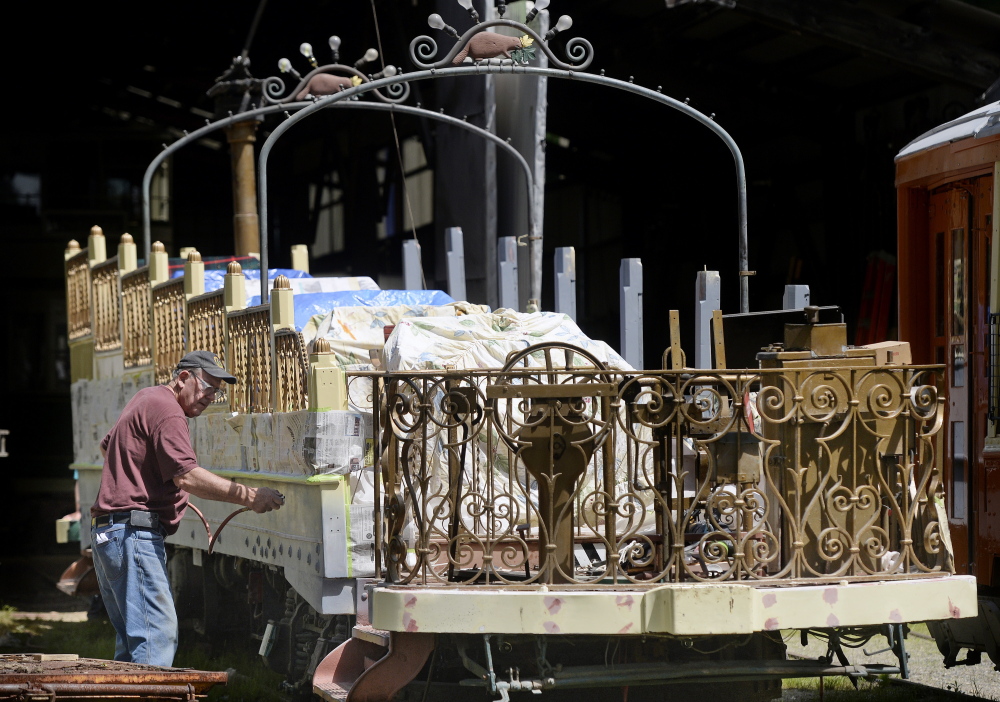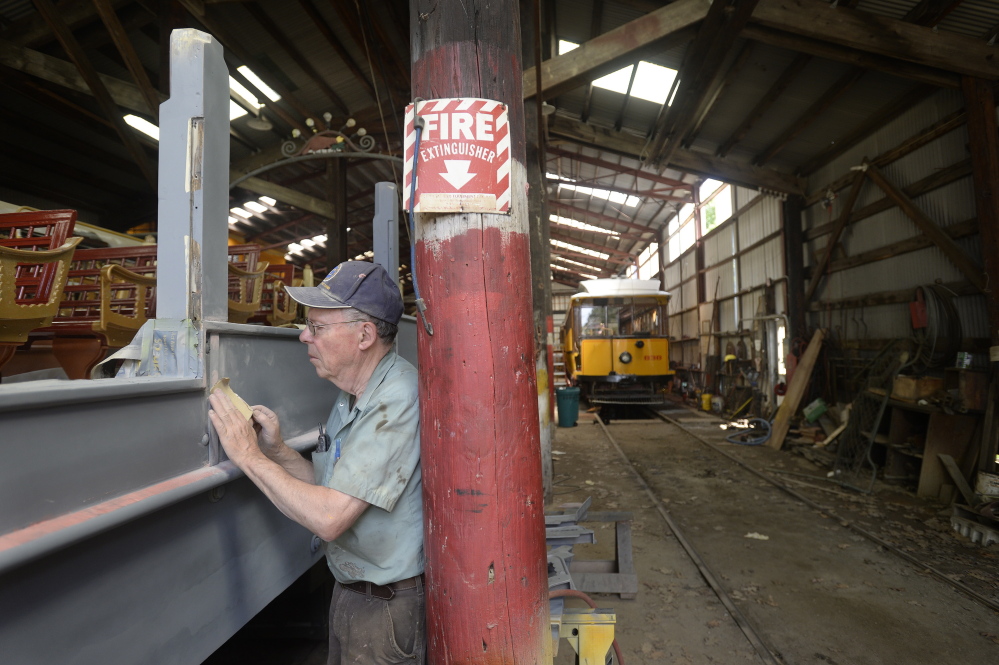KENNEBUNKPORT — Randy Leclair stands outside the Seashore Trolley Museum’s restoration shop, surrounded by the sights and sounds of history coming back to life.
An electric street car click-clacks its way down the track, the faint sound of a conductor talking to passengers drifting out the open windows. And in the dooryard of the restoration shop, two volunteers gently sand the sides of a nearly century-old trolley car bound for a paint job and, eventually, a triumphant return to the tracks.
“It casts your mind back to 100 years ago,” said Leclair, the museum’s restoration shop manager. “This really is a good time capsule of what life used to be like.”
The Seashore Trolley Museum, tucked in the woods away from the hustle and bustle of Kennebunkport village, is marking its 75th anniversary this summer by showcasing its extensive collection of electric trolley cars during a series of special events. A “Founders Day” celebration on July 5 will feature a narrated trolley parade and, more significantly, the return of the “Golden Chariot” Montreal observation car to the museum’s operating collection.
The nonprofit trolley museum is the largest and oldest public transportation museum in the world, said executive director Sally Bates. Last year the museum attracted 17,000 visitors.
“We address history from the context of public transportation and how public transportation has impacted people’s lives and communities over the decades,” Bates said. “It fills a unique niche.”
It also provides a lot of fun, Bates said, because visitors can explore large barns that house streetcars from across the country, watch restoration work in action, then hop aboard a trolley car for a trip through the woods for a first-hand look at how Mainers once traveled.
The museum was founded on July 5, 1939, after a group of railway enthusiasts – lamenting the end of streetcar service on the Biddeford & Saco line – pooled their resources and bought car No. 31 for $150. The mayor of Biddeford at the time allowed the purchase to go through, but ordered the car be moved out of town. It landed in Kennebunkport, where the museum has since amassed an extensive collection of 250 vehicles that includes streetcars from nearly every major U.S. city and several from other countries.
“The very fact this museum was created 75 years ago shows extraordinary foresight by the people who established it,” said state historian Earle Shettleworth. “We’re very fortunate to have (the museum) in Maine. It’s a very special and fascinating place.”
The museum’s creation coincided with the phasing out of electric streetcars in Maine towns and cities, Shettleworth said.
That form of public transportation grew out of the horse-drawn “horse cars,” which came to Maine in the 1860s. By the 1890s, electric trolley lines were used in cities like Portland to move people around the city and beyond.
“The fact you could have fairly rapid public transportation meant people who worked on the peninsula in Portland could afford, both in time and money, to live in the Deering area or over in what became South Portland,” Shettleworth said. “It was the beginning of what was known as the streetcar suburbs.”
But those streetcars became less relevant in the post-World War I era, when most middle class families had their own automobiles, Shettleworth said. By the late 1930s, electric streetcar lines were being shut down in favor of personal automobiles and buses.
As of July 5, museum visitors will get a taste of what it was like to travel through the streets of Montreal aboard the Golden Chariot, or Montreal No. 2, an open car with stadium-style seating that allows passengers an uninterrupted view ahead. Leclair, the restoration shop manager, said the streetcar was one of four built in 1906 and used for sightseeing tours in Montreal.
The car, complete with intricate gold-colored railings and carvings of beavers, was acquired by the museum in 1963. Once in Maine, the car was restored and operated until 2006, when it was taken off-line for repairs. Leclair said donations from members allowed the museum to restore the Montreal car this year, although it’s been a bit of a scramble to get it finished in time. Volunteers and museum employees have spent 4,000 hours during the past seven months into the job.
Last week, Donald Curry, the museum’s restoration project manager and museum volunteer of 61 years, helped prep the car for a new coat of pale yellow paint.
He said the work has been extensive, from restoring the seats to fixing two motors to rewiring the car. Before a wheel problem was fixed, the car would “bang, bang, bang” down the track, he said.
But, with just days to go before the big unveiling, the car was nearly ready to take its place once again as a favorite among visitors, Curry said. He took the car out on the tracks last week for a test ride just to be sure.
“It ran smooth as glass,” Curry said.
Copy the Story Link
Send questions/comments to the editors.






Success. Please wait for the page to reload. If the page does not reload within 5 seconds, please refresh the page.
Enter your email and password to access comments.
Hi, to comment on stories you must . This profile is in addition to your subscription and website login.
Already have a commenting profile? .
Invalid username/password.
Please check your email to confirm and complete your registration.
Only subscribers are eligible to post comments. Please subscribe or login first for digital access. Here’s why.
Use the form below to reset your password. When you've submitted your account email, we will send an email with a reset code.